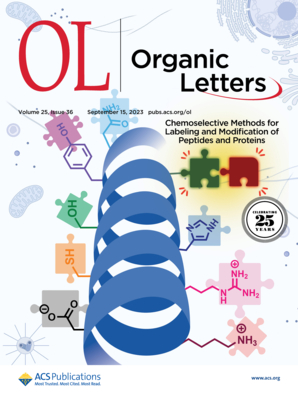化合物表征中精确质量测量数据的完整性
IF 5
1区 化学
Q1 CHEMISTRY, ORGANIC
引用次数: 0
摘要
化学方面的出版物包含大量的数据。研究很大程度上依赖于可重复性;因此,不一致或无效的数据会阻碍科学进步。例如,从错误数据中得出的结论可能具有误导性,并可能在随后的研究中传播错误。这些问题强调了确保高数据质量的重要性,特别是在科学界共享工作时。(1)精确质量测量(AMM),以前称为高分辨率质谱法(HRMS),用于指定或验证给定结构的分子式。给定分子的确切质量是有特点的,因为具有相同分子量的不同分子式的确切质量略有不同(通常在小数点后第三位或第四位)。在《有机快报》上,AMM是一种可以用来确定特定化合物身份的方法,但不能用来确定其纯度。(2)过去,大多数质谱分析中心要求用户提交一份包含其结构和建议公式的纸质表格。然后,中心工作人员将提供一份纸质报告,其中包含发现的精确质量和相应计算的精确质量(见图2),同时附上仪器生成的报告(图3)。大多数中心现在已经转向电子提交请求,并返回结果输出的电子形式(图3)。有了这些结果,研究人员要么手动将数据输入实验描述中,要么从电子报告中复制/粘贴数据。前者容易出现转录错误,如果复制/粘贴错误的数据,甚至后者也可能导致错误。图2。AMM测量纸质数据报告。图3。AMM的电子数据报告。由于有机化学报告中包含实验方案和化合物表征数据的支持信息文档的大小,人工识别所有不准确的地方几乎是不可能的。此外,还严重缺乏自动化和标准化数据质量评估的工具。(4) Freie Universität Berlin的Mathias Christmann教授在本期的随笔中披露了对来自Organic Letters的3000多个支持信息文件的分析,以了解这些数据中的AMM错误率。值得注意的是,发现了大量错误。大多数误差是由于没有考虑到电子的质量而产生的。这种非常小的误差通常不会影响测量,因为仪器制造商没有在他们提供的软件中考虑到它。然而,在101883个有AMM报告的化合物中,有10%存在值得关注的错误。这些错误的来源各不相同,包括排版错误(数字调换或数字不正确),在计算质量时使用不正确的数据(例如,质子为1.0,使用分子量─见图4),或使用不正确的分子式(例如,在需要时不包括H或Na)。只有0.3%的错误不能轻易归因于输入错误。图4。分子质量与结构绘图软件的精确质量。为了提高已发表作品的数据质量,建议研究人员以类似于现在使用checkCIF程序检查单晶结构数据的方式检查他们的AMM数据。(5)用户可以下载Christmann发布的软件(4),也可以使用我们使用此代码创建的web应用程序(图5)(检查AMM)。(6,7)此申请需要一个pdf文件,其中包含标准格式的AMM报告。(2)可以使用完整的支持信息文件,简化流程,因为程序能够识别这个较大文件中的AMM报告。用户可以设置他们想要的准确度阈值(在Organic Letters, 5 ppm是阈值(2))。该应用程序不存储任何用户数据,并提供一个报告,其中包含页码、根据给定公式重新计算的准确质量以及发现的错误的性质。帮助页面显示了一个示例报告(图6),并描述了如何将错误从最严重(A级警报)到最不严重(G级警报)进行分类。我们希望这个工具将为研究人员提供一个机会来识别和纠正任何不准确的地方,因为他们准备发表他们的工作。图5。登陆页检查AMM web应用程序。图6。检查AMM的样本报告。我们感谢Nathan L. Loud博士和Alice Wu(宾夕法尼亚大学)构思并绘制TOC图表(图1)。G.C.O.感谢NSF的奖学金(DGE-2236662)。我们非常感谢NSF (CHE 2400215)对这项工作的支持。本文引用了其他7个出版物。Organic Letters作者指南:针对需要与Java 1兼容的相关工具。本文章由计算机程序翻译,如有差异,请以英文原文为准。

On the Integrity of Accurate Mass Measurement Data in Compound Characterization
Publications in chemistry contain vast amounts of data. Research relies heavily on reproducibility; therefore, inconsistent or invalid data can hinder scientific progress. For example, conclusions drawn from erroneous data can be misleading and may propagate errors through subsequent research. These issues underscore the importance of ensuring high data quality, particularly when sharing work among the scientific community. (1)
求助全文
通过发布文献求助,成功后即可免费获取论文全文。
去求助
来源期刊

Organic Letters
化学-有机化学
CiteScore
9.30
自引率
11.50%
发文量
1607
审稿时长
1.5 months
期刊介绍:
Organic Letters invites original reports of fundamental research in all branches of the theory and practice of organic, physical organic, organometallic,medicinal, and bioorganic chemistry. Organic Letters provides rapid disclosure of the key elements of significant studies that are of interest to a large portion of the organic community. In selecting manuscripts for publication, the Editors place emphasis on the originality, quality and wide interest of the work. Authors should provide enough background information to place the new disclosure in context and to justify the rapid publication format. Back-to-back Letters will be considered. Full details should be reserved for an Article, which should appear in due course.
 求助内容:
求助内容: 应助结果提醒方式:
应助结果提醒方式:


